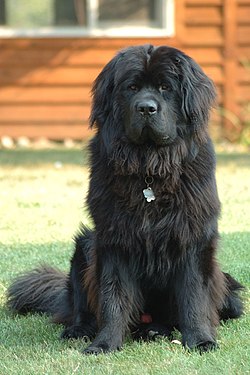Newfoundland dog
The Newfoundland is a large breed of dog that originated in Newfoundland. They were first used by fishermen and sailors to carry goods and would jump overboard to save people from drowning. Newfoundlands are great swimmers because of their waterproof fur, their webbed feet and their strong muscles.[1][2]
The Newfoundland is a very large dog breed, standing 26–28 inches (66–71 cm) and weighing 100–150 pounds (45–68 kg).[1] The largest Newfoundland found was 72 inches (180 cm) long and weighed 160 pounds (73 kg).[3] Their coat of fur is usually long and a black, brown or gray color.[1] Their facial hair is very short. The head is very large and the face is smooth with few wrinkles.[4] The ears are long and wide, and reach below the jaw.[2] The neck is strong and muscular.[4] The Newfoundland's chest is large and wide with a large lung capacity.[1][4] Because Newfoundlands are excellent swimmers, their thighs are very strong and muscular and their feet are tight. Their tail is very strong and is important for them to swim well.[4]
Newfoundlands can suffer from a lot of health problems. They are the fifth most likely breed to have hip dysplasia.[5] Newfoundlands can have problems with cystinuria in a similar way to humans.[6] Newfoundlands can inherit subvalvular aortic stenosis, a trait which hurts the heart.[7]
Newfoundlands are known to be very gentle and loyal dogs.[3][4] Because of their protective nature for children,[3] Newfoundlands have been used as watchdogs.[1] They have very thick fur so owners need to brush it once a week.[3]
Newfoundland Dog Media
Left to right, Black man York, Seaman, Lewis, Clark, Sacagawea, and her baby Pompey. Statue by Robert Scriver, in the Lewis and Clark National Historic Interpretative Center, Great Falls, Montana.
The classic "Landseer" markings of the breed relate to paintings like this by Sir Edwin Henry Landseer: Lion, a Newfoundland Dog, 1824. Some people believe that markings such as this are indicative of a separate breed known as the Landseer, named in his honour.
A Landseer
References
- ↑ 1.0 1.1 1.2 1.3 1.4 "Newfoundland". Encyclopædia Britannica Online. Retrieved 2010-08-23.
- ↑ 2.0 2.1 "Newfoundland". Britannica Online for Kids. Retrieved 2010-08-23.
- ↑ 3.0 3.1 3.2 3.3 "Dogs 101: Newfoundland". Animal Planet. 2008-10-28. Retrieved 2010-08-23.
- ↑ 4.0 4.1 4.2 4.3 4.4 "Newfoundland". Canadian Kennel Club. Retrieved 2010-08-23.
- ↑ Jones, Gary (2004). Veterinary Advice on Hip Dysplasia in Dogs (illustrated ed.). Interpret. p. 4. ISBN 1860542271.
- ↑ Ostrander, Elaine (2007). Elaine Ostrander, Urs Giger, Kerstin Lindblad-Toh (ed.). The Dog and Its Genome. Cold Spring Harbor Monograph. Vol. 44. CSHL Press. p. 355. ISBN 978-0879697815.
{{cite book}}: CS1 maint: multiple names: editors list (link) - ↑ Pyle, R. L.; Patterson, D. F.; Chacko, S. (1976). "The genetics and pathology of discrete subaortic stenosis in the Newfoundland dog". American Heart Journal. Mosby. 92 (3): 324–334. doi:10.1016/s0002-8703(76)80113-5. ISSN 0002-8703. PMID 986114.
| Wikimedia Commons has media related to Lua error in Module:Commons_link at line 62: attempt to index field 'wikibase' (a nil value).. |









